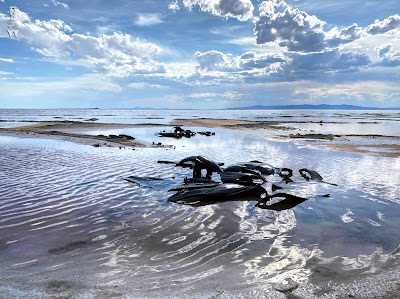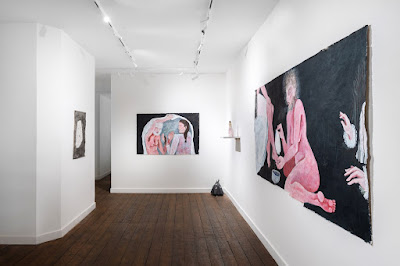Kai (Kari) Altmann at Final Hot Desert
It is 2020. We never thought it possible but the space between our eye and our screen(s) has never been tighter; fortunately we’re not at Google Glass levels of intimacy, but our screens are simultaneously our best friend and our infuriating nemesis, the needy friend who won’t let us go, always compelling and gaslighting us to keep coming back with little beeps and buzzes, arguably gradually eradicating the need for physical social spaces and interactions. I’ve texted you 64 times today, I don’t need to meet for that catch up drink.

It is with this that I think about how truly collaborative an exhibition is; without straying into cliché, the artworks are sufficient on their own, yet what Final Hot Desert have done by placing them on the shore, with a space that will change throughout the day depending on the tide, shows the power of strong curating. So we have artist, curator and gallery space (in whatever form this might take) accounted for, but with ‘TTOA: Native Arrangement II’, and similarly in all FHD’s projects, we are reminded of what truly brings it all together: the natural world. Of course, this is a problematic term, implying that mankind are inherently separated from what is ‘natural’ and therefore cannot maintain sustainable coexistence; but here I hope my intentions are clear, with this exhibition we are offered a glimpse of a contrarian exhibition model to the white cube, the four walls.
Installation view: Kai (Kari) Altmann, TTOA: Native Arrangement II, July 2020. Images courtesy of Final Hot Desert / Photography by Ben Sang and Tucker Nickman
With galleries and museums shut, avid art lovers have retreated online for shows in recent months, following curators and institutions. Platforms such as Instagram have allowed international audiences to access art shows they would not have usually been able to engage with, thanks to thorough documentation, mostly using photography and virtual reality. This is how I came across Final Hot Desert, a nomadic art initiative currently based in Salt Lake City, Utah. Being based in London, the art world I am used to is largely contained within four walls; whether considered institutional or independent, the architecture and physicality of the spaces are always paramount, even when they are precarious. In stark and stunning contrast, Final Hot Desert exhibitions, according to their website, are “held in both formal and informal art spaces with different levels of accessibility and permanence” . With one glance of their Instagram account, one can see artworks installed in a range of truly inspiring natural environments in and around Salt Lake City.
In July 2020, the collective hosted a body of work by Kai (Kari) Altmann, an artist who describes her practice as “globally” situated, alongside producing music as her alias, Hitashya. Installed in the Rozel Point pocket of Utah, Altmann’s work cleverly lurks in the ocean water, feeling very comfortable in this unusual environment, reminiscent of not only authority-funded public art installations but, in a tragic thematic polarity, beached aquatic animals. Sculptural works bear a matte black colour, also making visual reference to a car wreckage site. This allusion to destruction feels very much at place in the sea, given its often silenced violent histories and difficulties with geographic accountability. I am reminded of Ayesha Hameed’s work on the Black Atlantic , realising non-canonical histories of the triangular trade, but more recently of the horrors of migration and inhumane border control issues, which are less of a historical tragedy and more a moment of death and degradation through which we are living. Against the backdrop of crystalline skies and immersed in water, the ultimate symbol and element of tranquillity and life, its jagged edges become more dynamic and pointed.
Installation view: Kai (Kari) Altmann, TTOA: Native Arrangement II, July 2020. Images courtesy of Final Hot Desert / Photography by Ben Sang and Tucker Nickman
As anticipated, the photographic documentation is beautiful, due in no small part to the natural wonder of Rozel Point, but without being in Utah in person, the documentation formulates an idyll, an idealised perception of land and sea in blissful harmony. Observing the work as static image, it almost becomes irrelevant as to whether or not the exhibition actually exists in the real world. As Legacy Russell argues in her excellent recent book ‘Glitch Feminism’, the online and offline ‘worlds’ are not as separate as they once were; they are interchangeable and while one is not identical to the other in many ways, the online world is not some parallel, alien existence. When I first encountered Final Hot Desert, I assumed it was a virtual, e-World, taking inspiration from desert and other elemental landscapes, but alas it is real. But at a time where travel is at a minimum (and, indeed, a premium) and the majority of the gallery’s viewers will be doing so from a screen, how important is it that the exhibition truly exists?
There is one particular image of the work that is particularly arresting; Ben Sang and Tucker Nickman have done a fantastic job of presenting Altmann’s installation at its best, in prime moments of the day and allowing the art and the environment in which it is placed to work together. The image shows the sculptures from a bird’s eye view, depicting the full extent to which they bear a resemblance to a beached whale. Unlike the sort of representation one might find at a natural history museum, Altmann’s pieces are distinctly fragmented, cast ashore and broken yet somehow willing themselves to keep moving, keep active.

Installation view: Kai (Kari) Altmann, TTOA: Native Arrangement II, July 2020. Images courtesy of Final Hot Desert / Photography by Ben Sang and Tucker Nickman
According to the exhibition description, Altmann’s practice is influenced by “a global range of material, philosophical and spiritual understandings, bringing them together into new hybridised free zones and languages which reflect their entanglement in her own lived realities” . Pointing directly to global warming, fracking, pollution and social responsibility, these ‘understandings’ find a happy home at Rozel Point. As I investigate further into the Final Hot Desert project, I realise that their exhibitions are real (of course they are!) and am embarrassed by my own small-mindedness of the potential of exhibitions. Time, money and space are at a premium, but experimentation is not; when I next walk around my spot of south London, I will be looking for potential exhibition sites, and how a curator might not territorialise or claim said space, but work symbiotically to aid the artwork and environment alike in their respective desires to express themselves.




